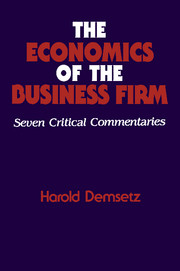Book contents
- Frontmatter
- Contents
- Preface
- First commentary: The firm of theory: its definition and existence
- Second commentary: Agency and nonagency explanations of the firm's organization
- Third commentary: Enterprise control, wealth, and economic development
- Fourth commentary: Profit maximization and rational behavior
- Fifth commentary: The use and abuse of accounting profit data
- Sixth commentary: Management compensation and tournament theory
- Seventh commentary: The intensity and dimensionality of competition
- References
- Index
Second commentary: Agency and nonagency explanations of the firm's organization
Published online by Cambridge University Press: 06 July 2010
- Frontmatter
- Contents
- Preface
- First commentary: The firm of theory: its definition and existence
- Second commentary: Agency and nonagency explanations of the firm's organization
- Third commentary: Enterprise control, wealth, and economic development
- Fourth commentary: Profit maximization and rational behavior
- Fifth commentary: The use and abuse of accounting profit data
- Sixth commentary: Management compensation and tournament theory
- Seventh commentary: The intensity and dimensionality of competition
- References
- Index
Summary
In the first commentary, I treated the internal organization of the firm as a different topic from that of the firm's existence. This creates a communication problem that we had best face here. The concept of the firm that is familiar to readers who have followed recent writings about the firm identifies the firm with a type of organization that relies heavily on the managed coordination of a work force. In this literature, for example, a reduction in the cost of transacting is viewed not only as a source of vertical integration, which clearly is an aspect of the firm's organization, but also as a substitution of the firm for the market, which comes close to identifying managed coordination as the essence of the firm. Consistent with this impression is the notion, deriving from Coase's work, that positive transaction cost is the reason the firm exists. In the first commentary, the firm is defined as an institution that specializes in the production of goods for others; on this view, a firm may exist if the efforts of some are managed by the direction of others, but this interpersonal direction is not necessary and is not the essence of the firm. A single person can constitute a firm, producing goods for the use of others.
Clearly organizational questions must be faced by the single-person firm. How big should the firm be? How vertically integrated should its activities be? What controls should the owner-worker in this firm use when dealing with suppliers?
- Type
- Chapter
- Information
- The Economics of the Business FirmSeven Critical Commentaries, pp. 15 - 39Publisher: Cambridge University PressPrint publication year: 1995
- 1
- Cited by



